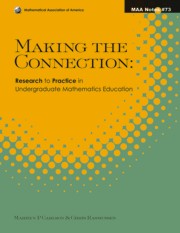Book contents
- Frontmatter
- Preface
- Contents
- Part 1 Student Thinking
- Part 2 Cross-Cutting Themes
- 2a Interacting with Students
- 13 Meeting New Teaching Challenges: Teaching Strategies that Mediate Between All Lecture and All Student Discovery
- 14 Examining Interaction Patterns in College-Level Mathematics Classes: A Case Study
- 15 Mathematics as a Constructive Activity: Exploiting Dimensions of Possible Variation
- 16 Supporting High Achievement in Introductory Mathematics Courses: What We Have Learned from 30 Years of the Emerging Scholars Program
- 2b Using Definitions, Examples and Technology
- 17 The Role of Mathematical Definitions in Mathematics and in Undergraduate Mathematics Courses
- 18 Computer-Based Technologies and Plausible Reasoning
- 19 Worked Examples and Concept Example Usage in Understanding Mathematical Concepts and Proofs
- 2c Knowledge, Assumptions, and Problem Solving Behaviors for Teaching
- 20 From Concept Images to Pedagogic Structure for a Mathematical Topic
- 21 Promoting Effective Mathematical Practices in Students: Insights from Problem Solving Research
- 22 When Students Don't Apply the Knowledge You Think They Have, Rethink Your Assumptions about Transfer
- 23 How Do Mathematicians Learn To Teach? Implications from Research on Teachers and Teaching for Graduate Student Professional Development
- About the Editors
19 - Worked Examples and Concept Example Usage in Understanding Mathematical Concepts and Proofs
from Part 2 - Cross-Cutting Themes
- Frontmatter
- Preface
- Contents
- Part 1 Student Thinking
- Part 2 Cross-Cutting Themes
- 2a Interacting with Students
- 13 Meeting New Teaching Challenges: Teaching Strategies that Mediate Between All Lecture and All Student Discovery
- 14 Examining Interaction Patterns in College-Level Mathematics Classes: A Case Study
- 15 Mathematics as a Constructive Activity: Exploiting Dimensions of Possible Variation
- 16 Supporting High Achievement in Introductory Mathematics Courses: What We Have Learned from 30 Years of the Emerging Scholars Program
- 2b Using Definitions, Examples and Technology
- 17 The Role of Mathematical Definitions in Mathematics and in Undergraduate Mathematics Courses
- 18 Computer-Based Technologies and Plausible Reasoning
- 19 Worked Examples and Concept Example Usage in Understanding Mathematical Concepts and Proofs
- 2c Knowledge, Assumptions, and Problem Solving Behaviors for Teaching
- 20 From Concept Images to Pedagogic Structure for a Mathematical Topic
- 21 Promoting Effective Mathematical Practices in Students: Insights from Problem Solving Research
- 22 When Students Don't Apply the Knowledge You Think They Have, Rethink Your Assumptions about Transfer
- 23 How Do Mathematicians Learn To Teach? Implications from Research on Teachers and Teaching for Graduate Student Professional Development
- About the Editors
Summary
Elsewhere in this volume, Watson and Mason discuss example generation from the students' perspective by highlighting some of the ways that example generation can be used to increase students' understanding of mathematics and improve their attitudes toward mathematics. This chapter complements this work by describing ways that teachers and textbooks might use examples to help undergraduates better understand mathematics. We distinguish between using worked examples to solve exercises and problems and using examples to help promote students' understanding of mathematical concepts and proofs. We begin with worked examples provided by the teacher or textbook. We then discuss the role of examples in building an understanding of a mathematical concept. Next we discuss how examples can be useful in understanding mathematical proofs. In each of these sections, we present specific suggestions that teachers might use in their own mathematics classrooms and we cite research studies that motivate and support these suggestions.
Worked Examples
The term “example” has multiple uses in mathematics education (cf., Watson & Mason, 2002). In some contexts, the word “example” refers to an illustration of a technique used to complete a certain type of mathematical task. For instance, a written solution to the question “Find all local minima and maxima of the function f(x)=x3+5x2-8” might be regarded as an example of how to solve minimum/maximum problems in an introductory calculus course. This is the way that the word example is often used in undergraduate textbooks, in which individual sections of the book frequently introduce a technique and then provide a series of examples in which the technique is applied.
- Type
- Chapter
- Information
- Making the ConnectionResearch and Teaching in Undergraduate Mathematics Education, pp. 245 - 252Publisher: Mathematical Association of AmericaPrint publication year: 2008
- 5
- Cited by

